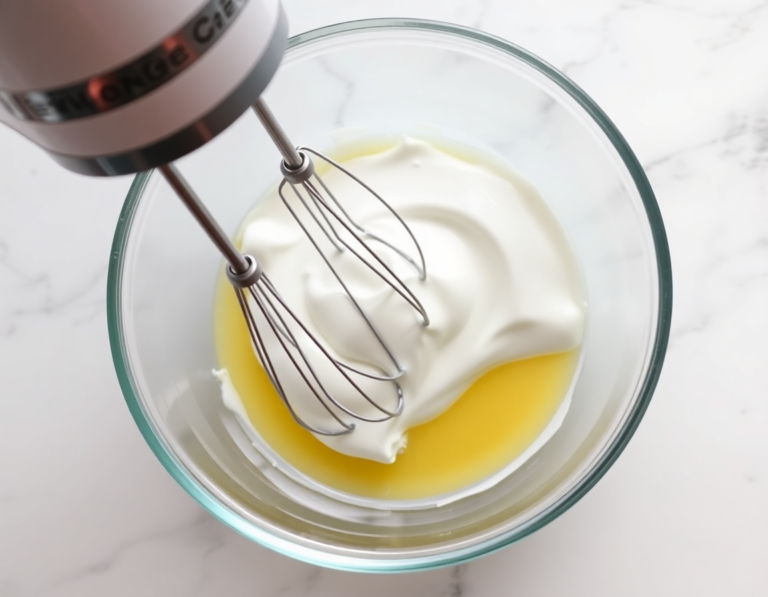Ah, pavlova—a dessert that’s as delightful as it is temperamental, kind of like my cat when she’s hungry. It might seem like just a meringue topped with cream and fruit, but there’s a certain magic in the crisp shell giving way to the soft, marshmallowy center. Remember last summer’s fruit market? Those berries were just begging to be scattered over a cloud of sweetness.
Steps
- Preheat your oven to 350°F (177°C) and line a large baking sheet with parchment paper or a silicone baking mat. Remember, you will reduce the oven temperature to 200°F (93°C) later.
- Using a handheld or stand mixer with a whisk attachment, beat the room temperature egg whites on medium-high until soft peaks form, which takes about 5 minutes. Gradually add superfine sugar in two parts, beating for 30 seconds between each addition. Once all the sugar is incorporated, increase the mixer speed to high and continue beating until the mixture becomes glossy and stiff peaks form, about 2 more minutes.
- Add vanilla extract and beat for an additional minute to ensure the peaks remain stiff. If they are not stiff enough, continue mixing on high speed. Gently fold in the cream of tartar and cornstarch using a rubber spatula.
- Spread the pavlova mixture onto the prepared baking sheet, forming an 8-9-inch circle. Use the back of a large spoon to create decorative peaks, ensuring the edges are relatively tall with a dip in the center.
- Place the pavlova in the oven and immediately reduce the heat to 200°F (93°C). Bake it for about 90 minutes until it is firm and dry, rotating the baking sheet if necessary to avoid uneven browning. Limit opening the oven to prevent cool air from affecting the baking process.
- Turn off the oven and allow the pavlova to cool inside. Once cooled, the pavlova can be stored covered at room temperature for up to two days or served immediately.
- When ready to serve, top the cooled pavlova with whipped cream and your choice of assorted toppings. Slice and enjoy this delightful dessert.
Ingredients
- 4 large egg whites
- 1 cup (200g) superfine sugar
- 1 teaspoon pure vanilla extract
- 1/2 teaspoon cream of tartar
- 1 teaspoon cornstarch
- Homemade whipped cream
- Fresh fruit
- Strawberry topping
- Lemon curd
- Other desired toppings
Nutritional Values
Calories: N/A | Total Fat: 0g | Saturated Fat: 0g | Cholesterol: 0mg | Sodium: 70mg | Total Carbohydrates: 200g | Dietary Fiber: 0g | Sugars: 200g | Protein: 12g
FAQ
- What is Pavlova?
- Pavlova is a dessert originating from New Zealand and Australia, known for its unique combination of textures. It features a crispy outer layer, a chewy top, and a soft marshmallow-like center, making it a delightful treat when paired with toppings like whipped cream and fresh fruits.
- What ingredients are essential for making Pavlova?
- The core ingredients for Pavlova are egg whites, sugar, an acid (such as cream of tartar or vinegar), cornstarch, and vanilla extract. Each ingredient plays a crucial role in achieving the desired texture and stability of the dessert.
- How should Pavlova be baked to achieve the perfect texture?
- To achieve the perfect Pavlova texture, start by baking it in a 350°F (177°C) oven and quickly reduce the temperature to 200°F (93°C). This method helps set the outer crust while preventing excessive spreading. The Pavlova should be pale with some cracks and bumps, and it should be cooled slowly in the oven to avoid deflation.
- What are some recommended toppings for Pavlova?
- Popular toppings for Pavlova include whipped cream, fresh berries, homemade lemon curd, and various fruit sauces. You can also add edible flowers, herbs, chocolate shavings, or seasonal fruits like mango and kiwi for extra flavor and decoration.
- Can Pavlova be prepared in advance?
- Yes, Pavlova can be made ahead of time. Once baked and cooled, it can be stored at room temperature for up to two days. However, it is best enjoyed right after adding the toppings, as it does not freeze well.
Tips
- Room Temperature Egg Whites: Ensure your egg whites are at room temperature before you start. This will help them whip faster and achieve a greater volume compared to cold egg whites.
- Use Superfine Sugar: To ensure the sugar dissolves completely into the egg whites, use superfine sugar. If you don’t have any, you can create your own by pulsing granulated sugar a few times in a food processor.
- Cool in the Oven: After baking, let the pavlova cool inside the oven to prevent it from cracking due to sudden temperature changes. This gradual cooling helps maintain its structure.
- Create a Well for Toppings: When spreading the pavlova mixture onto the baking sheet, leave a dip in the center. This will provide a perfect space to pile on your whipped cream and fruit toppings.
Equipment
- Stand mixer or handheld electric mixer
- Food processor (for superfine sugar)
- Silicone baking mat or parchment paper
- Ateco 849 piping tip (optional for mini pavlovas)


